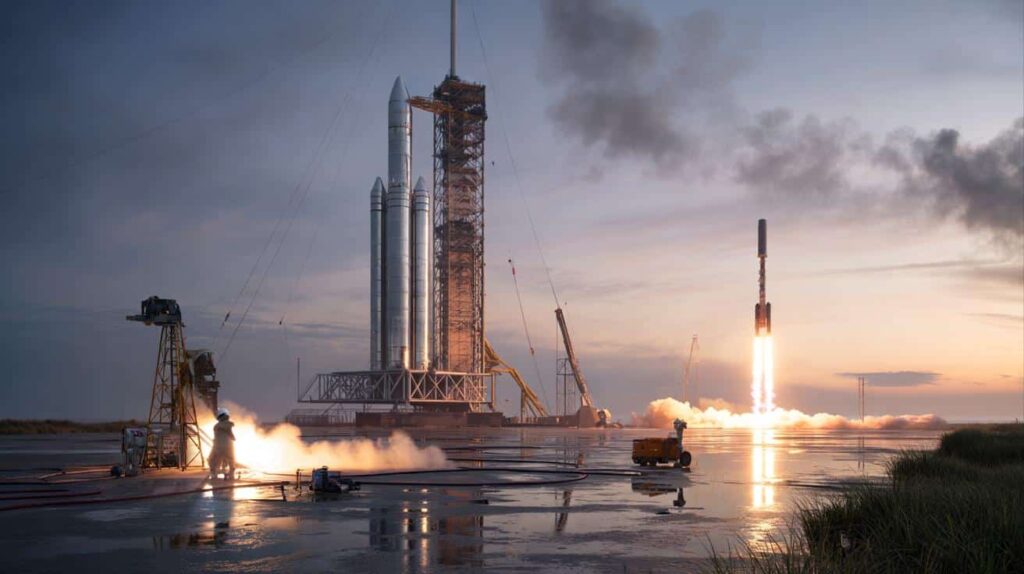The lights continue to shine through the Texas night, cranes still move gracefully, and welders still emit blue sparks. However, the next-generation Starship—the version designed to advance beyond test flights—keeps getting pushed into the future. The hardware is enormous. The calendar is more insistent.
The wind blew inland with a damp edge, bringing salt and a subtle hint of methane. I stood by the dunes as dawn merged with the Gulf and observed crews arriving with coffee cups and quiet nods. A Raptor test roared to life in the distance, the thud resonating over the flats like a drumbeat. Phones were pulled out. Heads turned. Then the sound faded, and everyone returned to their tasks. Something felt stagnant. A pause you could sense.
Where momentum met mass
SpaceX attempted to force time through sheer iteration. Upgrades to the pad, tile replacements, engine plumbing—every week brought a new task. The massive steel structures came together quicker than skeptics anticipated, but then reality applied the brakes. Starship’s size does not alter physics; it highlights every imperfection. What appeared to be a sprint transformed into a complicated relay, with the baton growing heavier with each lap.
Observe the rhythm. Falcon 9 operates like a metronome, but Starship’s timeline exists in fits and starts. In 2023 and 2024, the company accumulated several integrated flights that imparted harsh lessons about stage separation, reentry heating, and debris management. Each success came with caveats. Each failure provided data. You can tally Raptors produced, tiles installed, cryo tests conducted, and yet the gut feeling remains unchanged: reliable, repeatable performance isn’t falling into place yet.
The barrier isn’t drama. It’s accumulation. Thousands of TPS tiles that detach at the wrong angle. A hot-stage ring that enhances separation yet penalizes any plumbing misstep. Methalox that sways like a river in a storm. Then there’s the paperwork layer: environmental assessments, mishap reports, new mitigations. The calendar keeps shouting; the hardware responds softly. The likely scenario is a year of incremental progress and ground confidence, not the polished 2025 flight rhythm many envisioned.
Reading the signals—and what could still move the needle
There’s a method to gauge real readiness without relying on social media. Observe the pad. Significant rework on the deluge system, quick-disconnects, or tower arms usually indicates weeks—sometimes months—before the next major attempt. Monitor Notice to Mariners and airspace closures, but look for recurring patterns rather than isolated incidents. Short static fires imply plumbing checks; long-duration burns suggest confidence. When you witness full-duration Booster burns with clean shutdowns, that’s your indicator.
We’ve all experienced that moment when we refresh a livestream and convince ourselves a minor test signifies a significant leap. The wiser approach is to pair visuals with documents: FAA dockets, environmental submissions, and mishap closures. Let them align. For readers, the smartest strategy is to watch signals, not promises. Let’s be honest: not everyone does that daily. So set two reminders each month, skim for trends, and maintain your sanity.
Rockets don’t concern themselves with our schedules; they only care about margins.
The next significant advancements will likely stem from mundane tasks: tile retention formulas, Raptor preburner stability, autogenous pressurization nuances, and thermal modeling that aligns with reality. That’s not glamorous, yet it moves mountains.
- Pad and flame trench: look for fewer burn marks and shorter repair times.
- Raptor updates: increasing numbers of flight-like engines passing full-duration tests.
- TPS adjustments: less patchwork between flights, more consistent tile geometry.
- Regulatory path: fewer mitigations added, quicker closures after tests.
- Booster recovery drills: even simulated splashdowns indicate growing confidence.
If 2025 becomes a year of patience
Perhaps 2025 isn’t the grand tour. Maybe it’s the dress rehearsal for a program that will shape the next decade. The harsher reality is that 2025 resembles a dress rehearsal, not opening night. And that’s acceptable. The leap SpaceX is pursuing—full-flow methalox engines at scale, a stainless steel heat shield that endures, a super-heavy booster that performs—isn’t a software upgrade. It’s a monumental project with a loud factory attached.
The potential is persistent. Each grounded month consolidates experience. Teams discover where the design thrives and where it falters. The lunar deadlines will continue to shift, and the public’s patience won’t increase on cue, yet the work keeps forging a path. If the company embraces boring consistency—engine cycles that all align, TPS that withstands plasma—you’ll notice it when the flight profile transitions from spectacle to routine. That moment travels swiftly.
| Key Point | Detail | Reader Interest |
|---|---|---|
| Readiness signals exist on the ground | Pad rework cycles, static-fire durations, and regulatory filings reveal the true pace | Practical indicators to identify real progress without hype |
| Engineering debt is the hidden barrier | TPS reliability, Raptor stability, and propellant management influence schedule risk | Clear understanding of why flights are delayed and what needs to change |
| 2025 may be incremental, not explosive | More tests, fewer headlines, greater confidence per flight | Sets expectations and prevents whiplash from delays |
FAQ :
- Is Starship completely stalled?Not at all. Work continues daily on engines, TPS, and pad systems, but the transition to frequent, reliable flights appears further away than optimistic timelines suggested.
- What’s the single biggest blocker?No simple solution. Three factors dominate the schedule: Raptor reliability at scale, heat-shield durability, and post-flight turnaround that doesn’t consume weeks.
- Could SpaceX still fly Starship in 2025?Yes, but “fly” doesn’t equate to “operate.” Sporadic tests are likely; a steady rhythm seems ambitious without visible breakthroughs on margins.
- How do I know when a launch is genuinely close?Look for repeated, full-duration engine tests with clear data, minimal pad repairs between milestones, and regulatory windows that remain open rather than shifting.
- What does this mean for lunar plans?Schedules will adjust. NASA and partners prioritize reliability over bravado, so expect re-phasing while SpaceX strengthens the system one painstaking step at a time.








